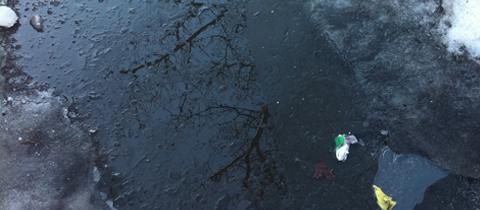Blog
Queering the gay app, Grindr

image: Jacob Gaboury, Compression Glitch, "Inches"
Below is a brief interview with Jacob Gaboury about our collaborative walk, Findr, that debuts Friday, June 24th.
Todd Shalom: So, i first found out about your work through ctrl+w33d. for those who don't know about it, can u explain?
Jacob Gaboury: CTRL+W33D is a queer internet art collective organized around a site on Tumblr. It is meant to be a kind of image aggregator, pulling images from all over the web and re-contextualizing them on the site. Some of the images are art, some of it spam, some of it pornographic. For me it is sort of a collection of queer image culture online.
Todd: did you have the trove of images first and then decide to do something with them, or did it all come together at the same time? in other words, how'd this find you?
Jacob: I think each member of w33d came about it in their own way. Nobody really had a stockpile of images, and a lot of what gets posted is just the kinds of images we come upon when trolling the Web. Those images lead to themes, or queer worlds (masking, zentai, gay travel, body morph videos, mix tapes, etc.) Most of my contributions come from queer image boards modeled after sites like 4chan, specifically sites for bears and furries.
Todd: i was once a furry in the serramonte mall for a photo company during easter. it's another conversation. so, this work also ties in with your phd studies. how is queer image culture known in academia?
Jacob: There's a relatively long-standing tradition of queer scholarship in the fields like comparative literature, performance studies, and cinema studies, which can be visual in a certain sense. But there is comparatively little work done on questions of queer technology or technological image-making.
Todd: is grindr considered queer technology? or technology used by gays/queers?
Jacob: I think Grindr is definitely a form of queer technology, in that it takes productive technologies such as geolocation, mapping, and social networking and queers them in service of alternate forms of what Samuel Delany has called "contact".
Todd: i feel like grindr and other apps/sites (i.e. manhunt) still face the same judgment within the american gay community as say, bathhouses/video booths. they're both some of the last taboos. what do u think?
Jacob: In many ways they've replaced those taboos, literally. I've also heard the accusation that they've led to the closing of a lot of the old gay nightclubs and bars, since people don't need to go out to hook up. There is also probably an argument for the way in which they've contributed to unsafe sex practices and the rise of barebacking culture since the early 2000s. What interests me more is the way in which these technologies transform public space, or transform spatial imaginaries through technologies. And this isn't limited to geolocation apps like Grindr. The Men Seeking Men section of Craigslist is also a popular site for these forms of contact - one that is much more socio-economically accessible than an application that can only be used on a $300 smartphone.
While M4M and Grindr may be used for similar purposes in urban areas like New York City, in rural areas it can create opportunities for contact that wouldn't otherwise be possible.
Todd: right. and so, for me, using grindr for the walk that we've created in nyc is an attempt to re-frame how we use the technology, with the intention that it might bring gays together with the perspective of building a shared space while also making us more conscious of how we (literally) create new paths in the city.
Jacob: Exactly. It's not that we're rehabilitating a potentially problematic technology, it's that we are using the technology to find new ways to interact and create a shared, networked physical space. We're hoping to create new forms of contact between anonymous strangers, and in so doing create new ways of navigating the city.
Slop and Spontaneous Society

Jon Cotner will be leading "Spontaneous Society" on June 9, 10, 16 and 17th in different places throughout Manhattan and Brooklyn. To give you some idea of what you're in for, read about one of his projects from this past winter.
From Jon:
In February 2011, the day following a blizzard, I took a 90-minute walk around Brooklyn during which every sentence I spoke contained the word “slop.” Here’s a 2-minute mp3 of that walk called “Slop”.
New York City is an infinite zone for walking and talking. On any given day, you can have either sustained or quick conversations – depending on your preference. Many dialogues unfold with people you’ll never see again (in spite of the common farewell “See you later”).
The “slop” walk was designed as an experiment. I’d searched my brain for a word uniting us all, one arousing laughter and frustration, and “slop” is what I came up with. So I hit the slushy sidewalks.
“Slop” ends with a violet-haired hairdresser on cigarette break in front of a slop pile. I said: “It must be nice to smoke a cigarette and contemplate the slop.” Her response: “Exac...you know what? That’s, I thought you were gonna say how beautiful – no, you’re absolutely right. Absolutely.”
I couldn’t have anticipated this response, or any of the others. At bottom “Slop” is a meditation on the city sidewalk’s humorous randomness.
+++
While you're at it, pick up one of Jon Cotner/Andy Fitch's highly praised "Ten Walks/Two Talks" from Ugly Duckling Presse.
Announcing "Total Detroit"
Here's a glimpse into Niegel Smith's healing walk in Detroit over the weekend of August 5, 2011. Click here for the walk description.
